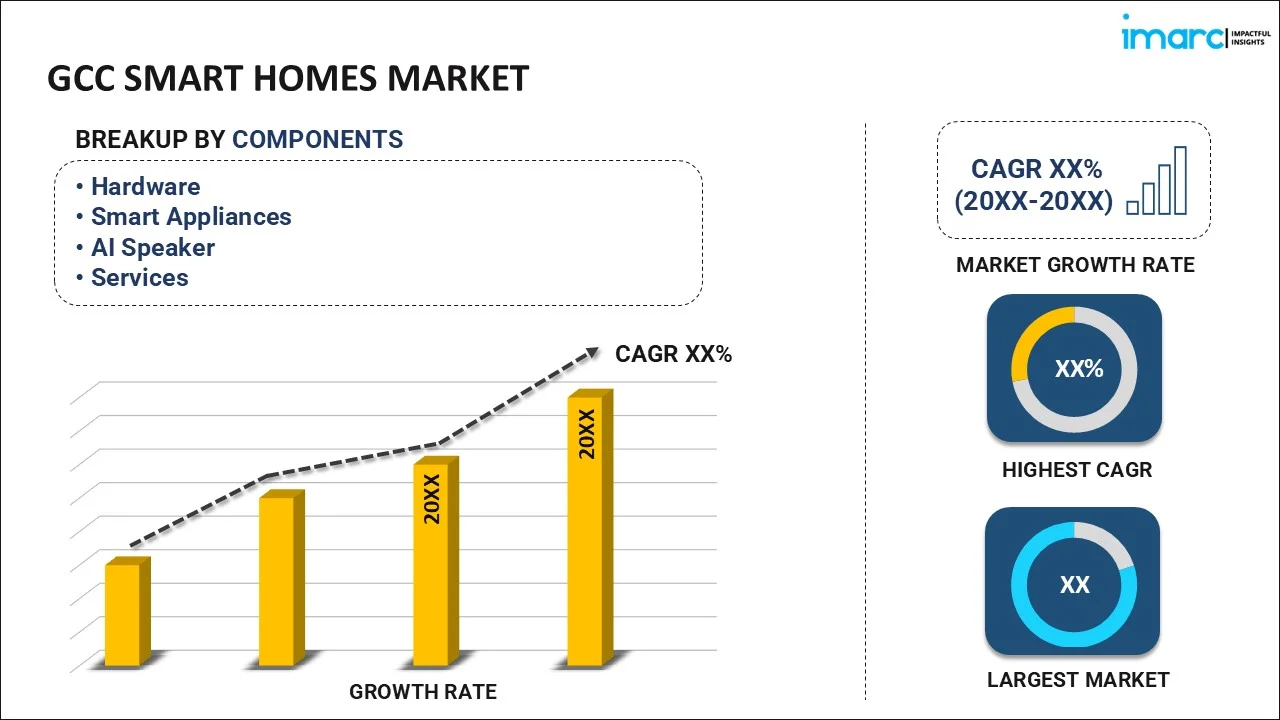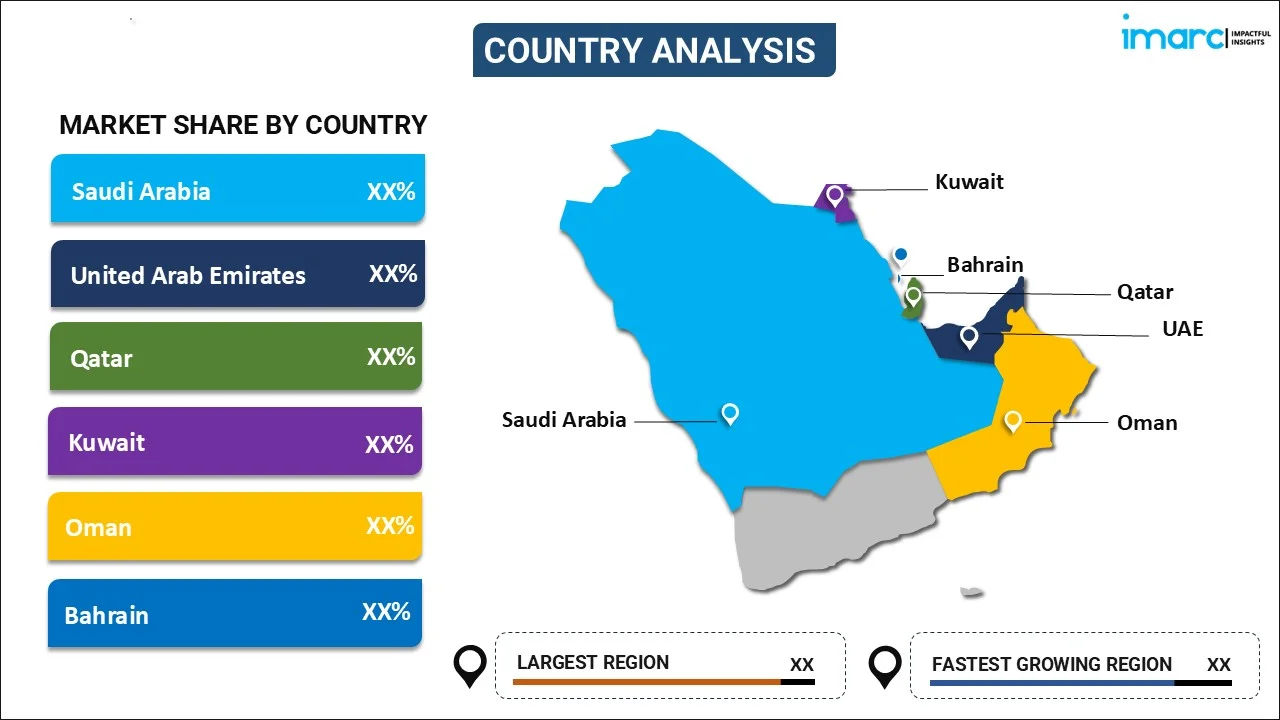
GCC Smart Homes Market Report by Component (Hardware, Smart Appliances, AI Speaker, Services), Application (Security and Surveillance, Lighting, Entertainment, Energy Management, HVAC, Smart Kitchen, Home Fitness and Wellness), and Country 2025-2033
Market Overview:
The GCC smart homes market size reached USD 2.7 Billion in 2024. Looking forward, IMARC Group expects the market to reach USD 7.0 Billion by 2033, exhibiting a growth rate (CAGR) of 11.3% during 2025-2033. Rapid urbanization and infrastructure development, the availability of cutting-edge technologies, growing focus on sustainability and energy conservation, widespread availability of high-speed internet, changing lifestyle preferences, and the rising integration of health monitoring and wellness features in smart homes represent some of the key factors driving the market.
|
Report Attribute
|
Key Statistics
|
|---|---|
|
Base Year
|
2024 |
|
Forecast Years
|
2025-2033
|
|
Historical Years
|
2019-2024
|
| Market Size in 2024 | USD 2.7 Billion |
| Market Forecast in 2033 | USD 7.0 Billion |
| Market Growth Rate (2025-2033) | 11.3% |
Smart Homes represent a technological integration within residential spaces that employs interconnected devices and systems to enhance efficiency, convenience, security, and comfort. Through the utilization of various technologies like the Internet of Things (IoT), artificial intelligence (AI), and automation, smart homes allow homeowners to control and monitor appliances, lighting, heating, cooling, security, and entertainment systems, all through centralized interfaces like smartphones or voice-activated devices. The core of a smart home is its ability to learn and adapt to the preferences and routines of its inhabitants. For instance, a smart thermostat might learn your preferred temperature settings and adjust accordingly without manual intervention. Smart lighting systems can be programmed to turn on or off at specific times or respond to motion sensors. Security is another critical aspect, with smart locks, surveillance cameras, and alarm systems providing real-time monitoring and remote access control. Integration with voice assistants like Amazon's Alexa or Google's Assistant enables voice command functionality, further enhancing user convenience.
GCC Smart Homes Market Trends:
The widespread availability of high-speed internet in the GCC represents one of the key factors driving the growth of the market across the region. This is further creating a conducive environment for smart home devices that rely on connectivity and cloud services which is boosting the growth of the market across the globe. In line with this, the GCC region's economic growth, particularly in countries like the UAE and Saudi Arabia, is leading to increased disposable income which is contributing to the growth of the market. This is creating a demand for luxury housing and lifestyle technologies, including smart homes, which is fueling the growth of the market. In addition to this, governments in various countries across the GCC region are actively promoting smart city projects and digital transformation, which is propelling the growth of the market. This support includes regulatory frameworks, incentives, and infrastructure development, which is facilitating the adoption of smart home technologies, thus driving the growth of the market. With an enhanced focus on sustainability and energy conservation, smart home technologies offer solutions to optimize energy usage, aligning with the region's goals to reduce carbon emissions and energy consumption which is influencing the growth of the market across the globe. The market is also driven by the availability of cutting-edge technologies, such as the Internet of Things (IoT) and artificial intelligence (AI), which enable the development of sophisticated smart home systems. These technological innovations contribute to the attractiveness and functionality of smart homes in the region, which is creating a positive outlook for the market across the region.
GCC Smart Homes Industry Segmentation:
IMARC Group provides an analysis of the key trends in each segment of the GCC smart homes market report, along with forecasts at the regional and country levels for 2025-2033. Our report has categorized the market based on component and application.
Breakup by Component:

- Hardware
- Security
- Home Automation
- Home Entertainment
- Home Healthcare
- Smart Appliances
- AI Speaker
- Services
- Energy Consumption and Management Services
- Security Services
- Healthcare Services
- Entertainment Services
A detailed breakup and analysis of the market based on the component has also been provided in the report. This includes hardware (security, home automation, home entertainment, home healthcare), smart appliances, AI speaker, and services (energy consumption and management services, security services, healthcare services, entertainment services).
Breakup by Application:
- Security and Surveillance
- Lighting
- Entertainment
- Energy Management
- HVAC
- Smart Kitchen
- Home Fitness and Wellness
A detailed breakup and analysis of the market based on the application has also been provided in the report. This includes security and surveillance, lighting, entertainment, energy management, HVAC, smart kitchen, and home fitness and wellness.
Breakup by Country:

- Saudi Arabia
- UAE
- Qatar
- Oman
- Kuwait
- Bahrain
The report has also provided a comprehensive analysis of all the major regional markets, which include Saudi Arabia, the UAE, Qatar, Oman, Kuwait, and Bahrain.
Competitive Landscape:
The report has also provided a comprehensive analysis of the competitive landscape in the GCC smart homes market. Competitive analysis such as market structure, key player positioning, top winning strategies, competitive dashboard, and company evaluation quadrant has been covered in the report. Also, detailed profiles of all major companies have been provided.
GCC Smart Homes Market Report Scope:
| Report Features | Details |
|---|---|
| Base Year of the Analysis | 2024 |
| Historical Period | 2019-2024 |
| Forecast Period | 2025-2033 |
| Units | Billion USD |
| Scope of the Report | Exploration of Historical and Forecast Trends, Industry Catalysts and Challenges, Segment-Wise Historical and Predictive Market Assessment:
|
| Components Covered |
|
| Applications Covered | Security and Surveillance, Lighting, Entertainment, Energy Management, HVAC, Smart Kitchen, Home Fitness and Wellness |
| Countries Covered | Saudi Arabia, UAE, Qatar, Bahrain, Kuwait, Oman |
| Customization Scope | 10% Free Customization |
| Post-Sale Analyst Support | 10-12 Weeks |
| Delivery Format | PDF and Excel through Email (We can also provide the editable version of the report in PPT/Word format on special request) |
Key Questions Answered in This Report:
- How has the GCC smart homes market performed so far and how will it perform in the coming years?
- What has been the impact of COVID-19 on the GCC smart homes market?
- What is the breakup of the GCC smart homes market on the basis of component?
- What is the breakup of the GCC smart homes market on the basis of application?
- What are the various stages in the value chain of the GCC smart homes market?
- What are the key driving factors and challenges in the GCC smart homes market?
- What is the structure of the GCC smart homes market and who are the key players?
- What is the degree of competition in the GCC smart homes market?
Key Benefits for Stakeholders:
- IMARC’s report offers a comprehensive quantitative analysis of various market segments, historical and current market trends, market forecasts, and dynamics of the GCC smart homes market from 2019-2033.
- The research study provides the latest information on the market drivers, challenges, and opportunities in the GCC smart homes market.
- Porter's five forces analysis assist stakeholders in assessing the impact of new entrants, competitive rivalry, supplier power, buyer power, and the threat of substitution. It helps stakeholders to analyze the level of competition within the GCC smart homes industry and its attractiveness.
- Competitive landscape allows stakeholders to understand their competitive environment and provides an insight into the current positions of key players in the market
Need more help?
- Speak to our experienced analysts for insights on the current market scenarios.
- Include additional segments and countries to customize the report as per your requirement.
- Gain an unparalleled competitive advantage in your domain by understanding how to utilize the report and positively impacting your operations and revenue.
- For further assistance, please connect with our analysts.
 Inquire Before Buying
Inquire Before Buying
 Speak to an Analyst
Speak to an Analyst
 Request Brochure
Request Brochure
 Request Customization
Request Customization




.webp)




.webp)












